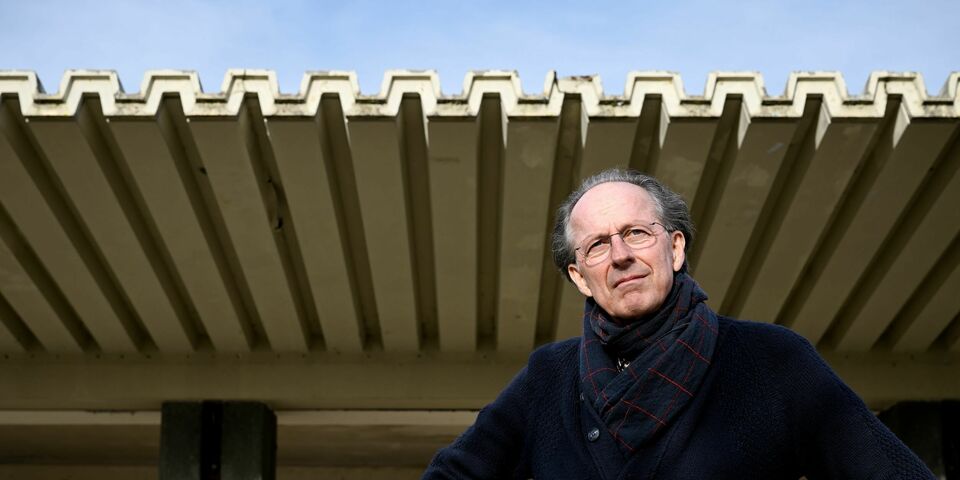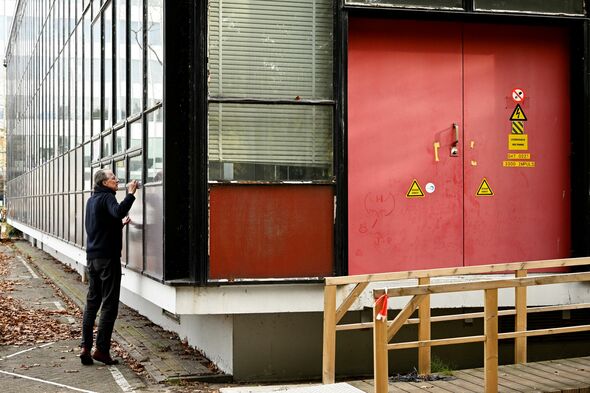“Architecture isn't entertainment”
The acclaimed art depot at the Museum Boijmans Van Beuningen in Rotterdam is not his cup of tea. “An isolated flower pot covered in mirrored panels, lacking any context and intended only to entertain. Wouldn't look out of place in Las Vegas,” says architectural historian Bernard Colenbrander, who tomorrow delivers his farewell speech. As a member of TU/e's Quality Committee he has tried to save the university campus from this kind of icon-idiocy. “The steward of a protected territory, that's how I see myself.”
An iconic building that Bernard Colenbrander does rate highly is the Bunker. Now, after two years of construction work, this concrete monument on the Kennedylaan, which used to house student society AOR (link in Dutch), the Mensa (university cafeteria) and three social associations, has become the pedestal of the high-rise BunkerToren. When the Bunker was sold in 2019, Colenbrander told Cursor that the building is "Hugo Maaskant at his most brutal". Only recently, the Eindhovens Dagblad newspaper sang Colenbrander's praises for saving from demolition this striking and somewhat forgotten design by the Rotterdam-born architect of the reconstruction era.
Summa College
“I wouldn't go that far, but Veronique Marks, the director of Real Estate at the time, and I were able to talk with the property developer about how much of the building could be preserved, and that was a discussion I was very pleased to have. After all, you can't assume that a commercial party is going to be receptive to the idea, and once the building was sold, we lost our say in the matter, with all the concomitant risks.” He says he's still disappointed that Summa College (link in Dutch) didn't move into the building. “They were deep into the negotiation process, but ultimately they thought it was too risky and they pulled out. Personally, I'd have really liked to have seen the building acquire an educational function.”
By contrast, he is pleased with how the BunkerToren has turned out. “I've got one foot in reality – this is a commercial project – but my other foot is standing in what I think of as a protected territory. And quality and profit maximization don't always go hand in hand. I still hope we'll see a public function occupying the base of the tower, as was agreed. Perhaps a restaurant or a gym, but there's no guarantee.”
Quality Committee
Having spent years on the TU/e Quality Committee, Colenbrander has always recognized the importance of preserving the original campus design, as it was once sketched out by architect Sam van Embden (link in Dutch). He saw himself as being the steward of this heritage – not, he points out, that he still sits on the Quality Committee; he stepped down in the summer. He immediately follows this up by saying that by supporting the reuse and renovation of existing buildings, the Quality Committee has “reanimated ” the campus. As a shining example, he cites Ceres, the former Ketelhuis, home for years to the Institute for Complex Molecular Systems (ICMS). Likewise, he is pleased with MetaForum. "The W-hall that forms the basis for this, was earmarked for full demolition. I am a bit unhappy with the crude cube that tops it now (occupied by the Department of Mathematics & Computer Science, ed.)."
A newcomer is Neuron, the former Laplacegebouw, where once the Rekencentrum started life, where Industrial Design was housed for a number of years, and where new tenants will soon be taking up residence, among them the Eindhoven Artificial Intelligence Systems Institute (EAISI). This building is scheduled for completion in February of next year. “Occupying the center of the building will be an artwork by Hella Jongerius (an industrial designer who graduated from the Design Academy in 1993, ed.). Representing a loom and filling the entire space from floor to ceiling, the artwork will be installed in the atrium once the building is in use.”
Read on below the photo.
Lieu de mémoire
A little farther northwest on the campus, where the construction of two high-rises of student accommodation recently got underway, three modest buildings and the former vestibule of the Paviljoen are of special interest to the professor of architectural history. “Here,” he says, “on the site where our university once began and which can rightly be regarded as the cradle of a whole host of departments, a number of elements have been preserved. There are roots here. Three modest pavilions and the former vestibule of the Paviljoen, which for almost sixty years housed the Department of Industrial Engineering & Innovation Sciences (IE&IS), are still intact and will be incorporated in the new build.”
A lieu de mémoire will be sited here, says Colenbrander. “It will be a place of collective memory, taking the form of a sculpture garden and an art project. I'm working on this together with policy officer Joep Huiskamp and landscape architect Paul Achterberg. The Executive Board is also fully aware of this project's historical dimension.” He believes that the two residential towers will sit well with the concept for the campus once designed by Van Embden, “but I have some concerns about the student village that will be built between the two towers. Given the major challenges currently facing the construction sector, I fear that we're going to end up with a stripped-down version of what we intended. It's something we've just had to accept.”
Off-the-rack architecture
Toward various construction projects announced or built in the municipality of Eindhoven he has previously been less sympathetic. In 2010 he disparaged the apartment complex next to the PSV stadium as ‘off-the-rack architecture’ and eighteen months ago he criticized Winy Maas's plans for the shopping mall De Heuvel. “He (Winy Maas, ed.) is an architect who produces spectacles, designs more rooted in visual culture than in architectural tradition. His buildings are incidents, by which I mean they aren't incorporated into a vision of urban architectural planning. As a city whose structure is fairly weak – a chaotic city center with few striking landmarks – Eindhoven isn't suited to these buildings.” Colenbrander still holds this opinion: “Eindhoven has made a mess of its urban architecture. This city lacks the logic of cities such as Amsterdam, Rotterdam or Den Bosch, where a tolerable alternative is sought, where the public domain belongs to the streets.”
He is still supervising twenty doctoral candidates and is clearly pleased with the stream of candidates that find their way to him. As he won't be able to see them all through to the end, he hopes to leave them in good hands. “Actually, from the moment I arrived seventeen years ago, there have been discussions with architects and other groups here within our department. In that respect, as an architectural historian I've always been happy to commit transgressive behavior.”
At the moment, he is writing a value assessment for Impuls, the somewhat dilapidated little building across from Luna that a while ago was used as a site hut for the construction workers who were renovating Atlas and which now provides storage space. The building, he believes, fits nicely into its surroundings and is definitely worth preserving for future generations.



Discussion